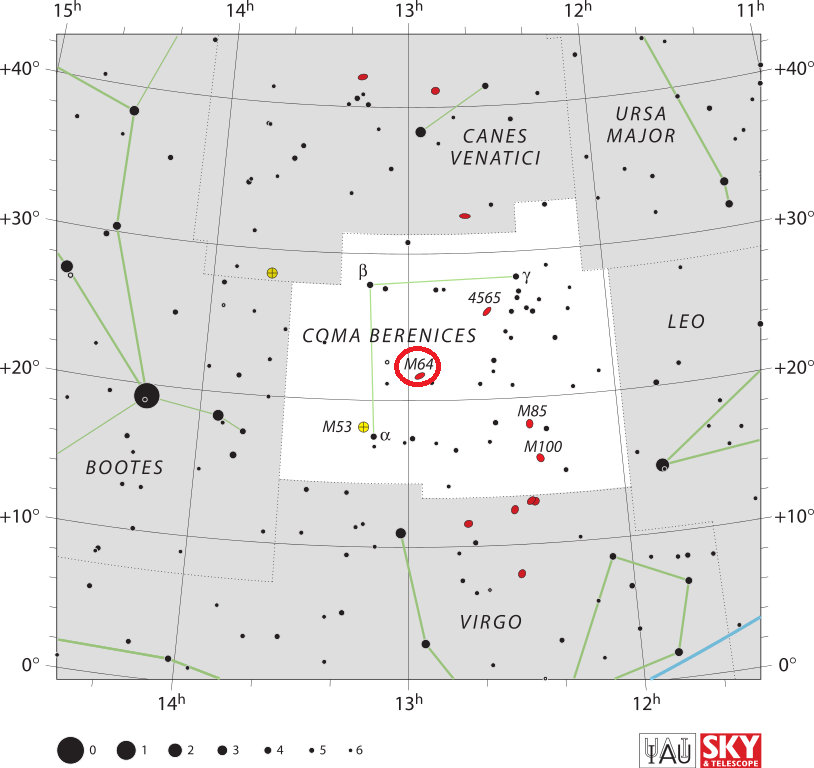Messier 64 (M64), also known as the Black Eye Galaxy, Evil Eye Galaxy, or Sleeping Beauty Galaxy, is a famous spiral galaxy located in the constellation Coma Berenices. Messier 64 has an apparent magnitude of 9.36 and lies at a distance of 24 million light years from Earth. The galaxy has the designation NGC 4826 in the New General Catalogue.
The Black Eye Galaxy occupies an area of 10.71 x 5.128 arc minutes, corresponding to a linear diameter of 70,000 light years. It is a popular object among amateur astronomers because its bright core is visible even in small telescopes.
Binoculars reveal only a faint, irregular patch of light, but 4-inch telescopes easily show the galaxy’s large, bright nucleus and if observing conditions are particularly good, its large dark dust lane.
The dust lane is even easier to see in 6-inch telescopes, while 8-inch instruments also reveal the galaxy’s outer regions, which appear as a large halo of wispy nebulosity.
The Black Eye Galaxy is not particularly easy to find. It is located about a degree to the northeast of the star 35 Comae Berenices, which lies 4 to 5 degrees to the north-northeast of Diadem, Alpha Comae Berenices, a binary star with a visual magnitude that varies from 4.29 to 4.35.
The globular cluster Messier 53 can be found only 1 degree to the northeast of Diadem. Both the cluster and the star lie about 15 degrees to the west of Arcturus, the fourth brightest star in the night sky. M64 lies 19 degrees west and a little north of Arcturus. The best time of year to observe M64 from northern latitudes is during the spring.
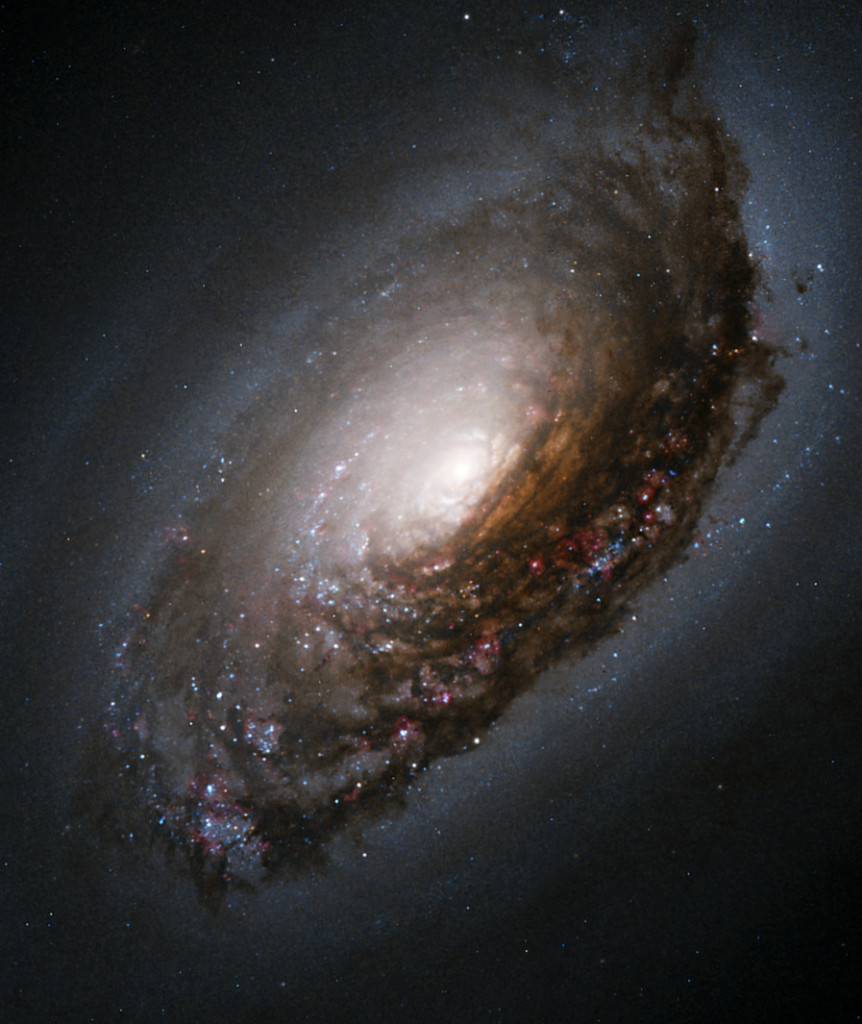
Astronomers believe that the oppositely rotating gas arose when M64 absorbed a satellite galaxy that collided with it, perhaps more than one billion years ago. This small galaxy has now been almost completely destroyed, but signs of the collision persist in the backward motion of gas at the outer edge of M64. Image: NASA and The Hubble Heritage Team (AURA/STScI)
Messier 64 is known for the spectacular large dark band of dust in front of its bright central region, which has earned the galaxy the nicknames the Black Eye or Evil Eye. The dust band has also helped astronomers estimate which side of M64 is nearer to us. It appears to be the galaxy’s southern side.
Messier 64 is a member of the Canes Venatici I Group, also known as the M94 Group or the Canes Venatici Cloud, a small, loose group of galaxies within the Virgo Supercluster, located in the constellations Coma Berenices and Canes Venatici. The group was named after the bright spiral galaxy Messier 94, also known as the Cat’s Eye Galaxy or Croc’s Eye Galaxy, located in Canes Venatici constellation.
The Black Eye Galaxy is home to about 100 billion stars. It is receding from us at 408 km/s. No supernovae have been detected in it so far. M64 does not contain any known Cepheid variables, which is very unusual for a galaxy this close to us and means that its distance is merely estimated at 24 million light years, but far from certain.
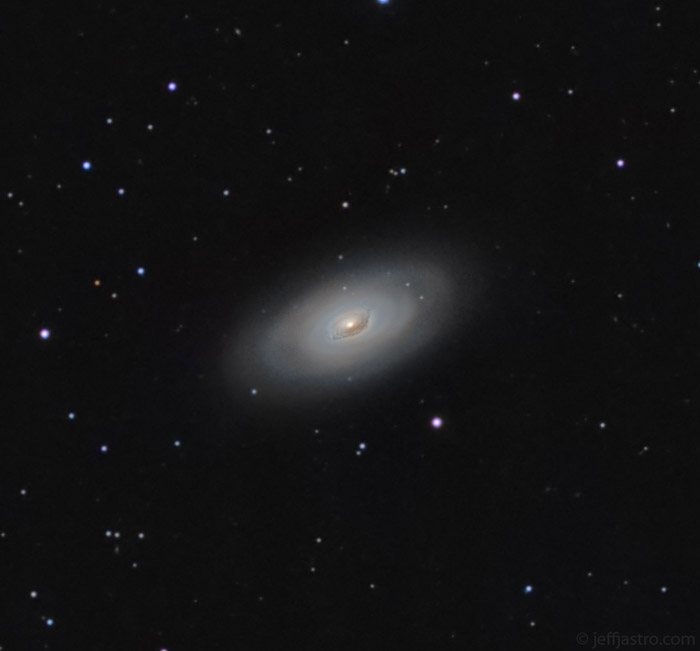
Messier 64 has two counter-rotating disks roughly equal in mass, possibly as a result of a merger with a smaller satellite galaxy in a retrograde orbit or of ongoing accretion of gas clouds from the interstellar neighbourhood. The dark dust lane that blocks the light of the galaxy’s central region may in fact be material from the smaller galaxy that hasn’t settled into the larger galaxy’s orbital plane yet.
The inner disk of M64, roughly 3,000 light years in radius, rubs along the outer disk, which spans about 40,000 light years and rotates in the opposite direction at about 300 km/s.
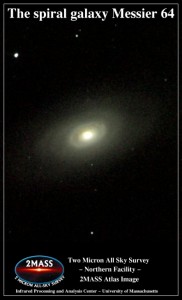
The rubbing of the two counter-rotating disks results in an intense burst of star forming activity in the region where the disks’ gases collide and are compressed.
While the interstellar gas in the galaxy’s outer regions rotates in the opposite direction from the gas and stars in the inner disk, all the stars in M64 are rotating in the same direction.
In his 1988 book Color Atlas of Galaxies, J.D. Wray proposed that the Black Eye Galaxy may be considered a prototype for a class of galaxies known as Evolved Second Wave Activity Galaxies (ESWAG).
These are galaxies that are experiencing a second wave of star formation. Their main spiral pattern contains stars of an intermediate age.
Star forming activity first evolved outside and continued for as long as there was enough interstellar material in the region. Then it gradually ceased and did not start again until new material started accumulating and flowing back from the evolved stars by stellar wind, supernova explosions and planetary nebulae.
Once there was enough new material, the formation of new stars started again. In M64, the second wave of star forming activity seems to have reached the area where the dark dust lane appears.
The Black Eye Galaxy is a known radio source, catalogued as PKS 1254+21.
Messier 64 was discovered by the English astronomer Edward Pigott on March 23, 1779. Pigott noted:
… on the 23rd of March, I discovered a nebula in the constellation of Coma Berenices, hitherto, I presume, unnoticed; at least not mentioned in M. de la Lande’s Astronomy, nor in M. Messier’s ample Catalogue of nebulous Stars [of 1771]. I have observed it in an achromatic instrument, three feet long, and deduced its mean R.A. by comparing it to the following stars [..; yielding a] Mean R.A. of the nebula for April 20, 1779, of 191d 28′ 38″.
Its light being exceedingly weak, I could not see it in the two-feet telescope of our quadrant, so was obliged to determine its declination likewise by the transit instrument. The determination, however, I believe, may be depended upon to two minutes: hence, the declination north is 22d 53″1/4 [sic]. The diameter of this nebula I judged to be about two minutes of a degree.
German astronomer Johann Elert Bode discovered M64 independently 12 days later, on April 4, 1779. He wrote, “On April 4 of this year, when I located the comet in the evening north above Vindemiatrix in the Virgin, I have found a small nebulous star, about 1 deg to the northeast near the 35th star of Berenice’s Hair, the longitude of which is about 1 deg [Lib] [181d] and the latitude is 26d north.”
Bode’s discovery was the first to be published, followed by Messier’s, while Pigott’s discovery of the object was largely ignored until Bryn Jones recovered it in April 2002.
Charles Messier found the object on March 1, 1780 and added it to his catalogue as M64, describing it as a “nebula discovered in Coma Berenices, which is about half as apparent as that which is below the hair [Messier 53]. M. Messier has reported its position on the Chart of the Comet of 1779.”
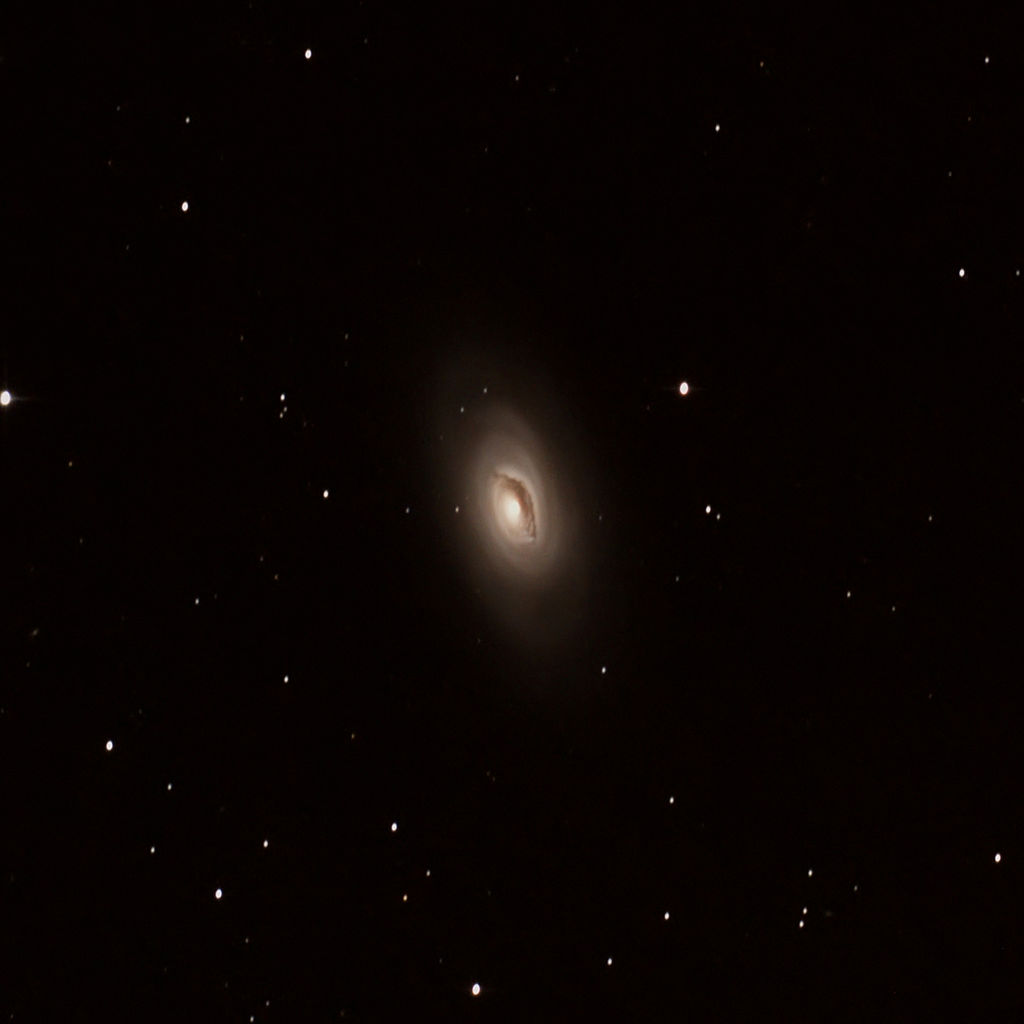
William Herschel was the first to discover the galaxy’s dark band of dust. He was also the one responsible for the name Black Eye. After observing M64 on February 13, 1787, he noted, “A very remarkable object, mE. [much elongated], about 12′ long, 4′ or 5′ broad, contains one lucid spot like a star with a small black arch under it, so that it gives one the idea of what is called a black eye, arising from fighting.”
John Herschel catalogued the object as h 1486 and later added it to the General Catalogue as GC 3321. He described M64 as “bright; very large; very much extended; very suddenly much brighter toward the middle; well examined,” adding, “I am much mistaken if the nucleus not be a double star, in the general direction of the nebula: magnification 320 much increases this suspicion; 240 shows well a vacuity below (north of) the nucleus. The nebula is 8′ or 9′ long, and 2′ broad.”
Admiral William Henry Smyth observed M64 in March 1837 and offered the following description:
A conspicuous nebula, between Berenice’s Hair, and the Virgin‘s left arm; discovered by M. [Messier] in 1780, who, however, only saw it very faintly. Yet it is magnificent both in size and brightness, being elongated in a line np [north preceding, NW] and sf [south following, SE], and blazing to a nucleus. This is the object which Sir Charles Blagden, on being shown it by WH, likened to a black eye, which though odd, is considered not an inapt comparison.
Sir John Herschel examined this nebula very minutely. He considers it resolvable, though not resolved; and adds, “I am much mistaken if the nucleus be not a double star, in the general direction of the nebula; 320 much increases this suspicion; 240 shows well a vacuity below the nucleus.” My utmost endeavours only shows it thus: [drawing]
This nebula was fixed by differentiating it with Epsilon Virginis, the bright star 11deg south of it; and it lies between Arcturus and Delta Leonis, about 20deg west from the former bright star.
FACTS
| Object: Galaxy |
| Type: Spiral |
| Class: (R)SA(rs)ab, HIISy2 |
| Designations: Messier 64, M64, NGC 4826, Black Eye Galaxy, Sleeping Beauty Galaxy, Evil Eye Galaxy, PGC 44182, UGC 8062, 2E 1254.2+2157, IRAS F12542+2157, MCG+04-31-001 |
| Features: Prominent dark, absorbing band of dust in front of the galaxy’s bright nucleus |
| Constellation: Coma Berenices |
| Right ascension: 12h 56m 43.7s |
| Declination: +21°40’58” |
| Distance: 24 million light years (7.36 megaparsecs) |
| Number of stars: 100 billion |
| Apparent magnitude: +9.36 |
| Apparent dimensions: 10′.71 x 5′.128 |
| Radius: 35,000 light years |
| Redshift: 0.001361 |
| Heliocentric radial velocity: 408 km/s |
| Galactocentric velocity: 400 km/s |
LOCATION
